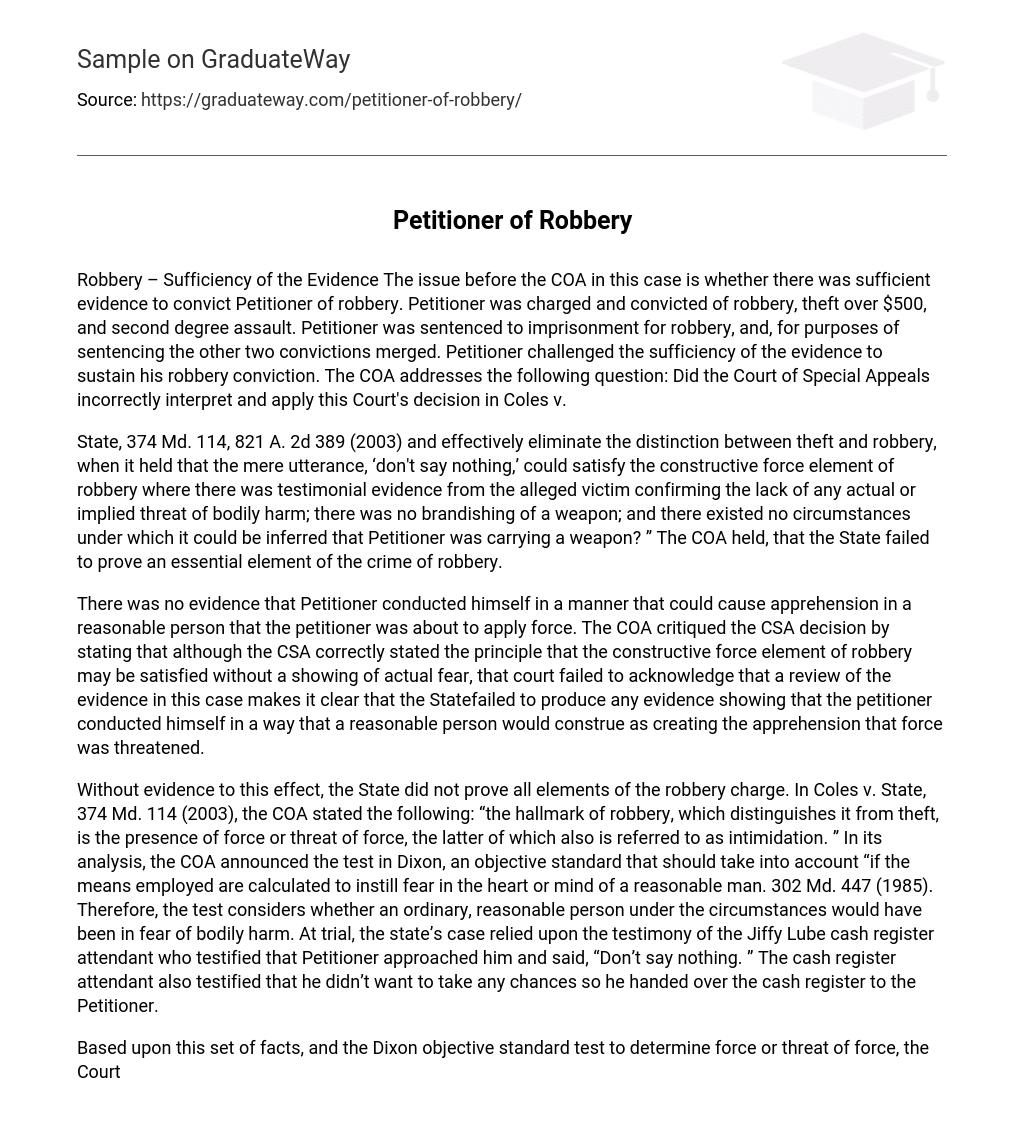Robbery – Sufficiency of the Evidence The issue before the COA in this case is whether there was sufficient evidence to convict Petitioner of robbery. Petitioner was charged and convicted of robbery, theft over $500, and second degree assault. Petitioner was sentenced to imprisonment for robbery, and, for purposes of sentencing the other two convictions merged. Petitioner challenged the sufficiency of the evidence to sustain his robbery conviction. The COA addresses the following question: Did the Court of Special Appeals incorrectly interpret and apply this Court’s decision in Coles v.
State, 374 Md. 114, 821 A. 2d 389 (2003) and effectively eliminate the distinction between theft and robbery, when it held that the mere utterance, ‘don’t say nothing,’ could satisfy the constructive force element of robbery where there was testimonial evidence from the alleged victim confirming the lack of any actual or implied threat of bodily harm; there was no brandishing of a weapon; and there existed no circumstances under which it could be inferred that Petitioner was carrying a weapon? ” The COA held, that the State failed to prove an essential element of the crime of robbery.
There was no evidence that Petitioner conducted himself in a manner that could cause apprehension in a reasonable person that the petitioner was about to apply force. The COA critiqued the CSA decision by stating that although the CSA correctly stated the principle that the constructive force element of robbery may be satisfied without a showing of actual fear, that court failed to acknowledge that a review of the evidence in this case makes it clear that the Statefailed to produce any evidence showing that the petitioner conducted himself in a way that a reasonable person would construe as creating the apprehension that force was threatened.
Without evidence to this effect, the State did not prove all elements of the robbery charge. In Coles v. State, 374 Md. 114 (2003), the COA stated the following: “the hallmark of robbery, which distinguishes it from theft, is the presence of force or threat of force, the latter of which also is referred to as intimidation. ” In its analysis, the COA announced the test in Dixon, an objective standard that should take into account “if the means employed are calculated to instill fear in the heart or mind of a reasonable man. 302 Md. 447 (1985). Therefore, the test considers whether an ordinary, reasonable person under the circumstances would have been in fear of bodily harm. At trial, the state’s case relied upon the testimony of the Jiffy Lube cash register attendant who testified that Petitioner approached him and said, “Don’t say nothing. ” The cash register attendant also testified that he didn’t want to take any chances so he handed over the cash register to the Petitioner.
Based upon this set of facts, and the Dixon objective standard test to determine force or threat of force, the Court cannot conclude that a rational trier of fact could have found that the State proved all the essential elements of robbery beyond a reasonable doubt. The cash attendant’s testimony merely conveyed the subjective state of mind of the cashier, and does not support an inference that Petitioner might have had a weapon.
A reasonable person in these circumstances even one who was not taking any chances, would not have assumed that Spencer possessed a weapon simply because he said “don’t say nothing. ” Thus, the COA concluded that the State failed to prove an essential element of the robbery charge, and Petitioner’s robbery conviction should not stand. Stabb v. 32





